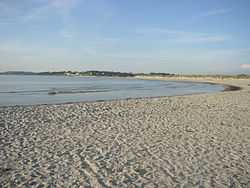Sola
| Sola kommune | |||
|---|---|---|---|
| Municipality | |||
 | |||
| |||
 | |||
| Coordinates: 58°52′48″N 005°37′43″E / 58.88000°N 5.62861°ECoordinates: 58°52′48″N 005°37′43″E / 58.88000°N 5.62861°E | |||
| Country | Norway | ||
| County | Rogaland | ||
| District | Jæren | ||
| Administrative centre | Sola | ||
| Government | |||
| • Mayor (1995–) | Ole Ueland[1] (H) | ||
| Area | |||
| • Total | 70 km2 (30 sq mi) | ||
| • Land | 69 km2 (27 sq mi) | ||
| Area rank | 408 in Norway | ||
| Population (2006) | |||
| • Total | 20,138 | ||
| • Rank | 46 in Norway | ||
| • Density | 282/km2 (730/sq mi) | ||
| • Change (10 years) | 12.5 % | ||
| Demonym | Solabu[2] | ||
| Time zone | CET (UTC+1) | ||
| • Summer (DST) | CEST (UTC+2) | ||
| ISO 3166 code | NO-1124 | ||
| Official language form | Neutral | ||
| Website | www.sola.kommune.no | ||
|
| |||
| Historical population | ||
|---|---|---|
| Year | Pop. | ±% |
| 1951 | 5,025 | — |
| 1961 | 7,075 | +40.8% |
| 1971 | 9,898 | +39.9% |
| 1981 | 12,673 | +28.0% |
| 1991 | 15,982 | +26.1% |
| 2001 | 19,023 | +19.0% |
| 2011 | 23,350 | +22.7% |
| 2021? | 30,512 | +30.7% |
| 2031? | 36,489 | +19.6% |
| Source: Statistics Norway.[3] | ||
Sola is a municipality in Rogaland county, Norway. It is part of the region of Jæren. The old municipality of Håland was divided into Sola and Madla in 1930.
Stavanger Airport is located here. With usually ample supplies of wind and waves, the Sola sand beach is a popular place for windsurfing. Sola Municipality is situated in the Northern area of Jæren. Stavanger, Klepp and Sandnes are neighbouring municipalities. In the western part of Sola, there are 5 kilometres (3.1 mi) of long, sandy beaches facing the North Sea. Sola covers an area of 69 square kilometres (27 sq mi). The population is about 20,000. People have been living in Sola since the Stone Age.
General information
Name
The municipality (originally the parish) is named after the old Sola farm (Old Norse: Sóli), since the first church was built there. The name is very old and the meaning is unknown, although it contains the Norse word sól which translates as Sun, therefore it could have some link to the sun.
Coat-of-arms
The coat-of-arms is from modern times. They were granted on 1982. The arms show two waves which symbolize all of the sandy beaches in the municipality.[4]
History
According to Snorre Sturlason the battle of Hafrsfjord took place in the year AD 872, probably outside Ytraberget. Harald Fairhair, the first king of Norway, is celebrated for having united Norway at this notable battle.
The stone crosses at Tjora date from about the year 1150. In early Christian times, these stone crosses were used as gathering points for religious ceremonies before churches were built. Sola Church Ruins is built on the ruins of a Romanesque stone church dating from about the year 1120. The stone church probably replaced an older wooden church in the area. This wooden church was possibly the one that Erling Skjalgsson had built when he converted to Christianity at the end of the 10th century. A fascinating story lies behind this unique church. The artist Johan Bennetter (1822–1904) used the church as a studio and lived there with his family. During World War II, most of the church was demolished. It was later reconstructed, and the restoration was finished in 1995. In the Sola Church Ruins area, there is a monument of Erling Skjalgsson (AD 975-1028), one of Sola's most famous men. This notable Viking leader has been given the honour of having introduced Christianity to Sola.
The Aviation History Museum gives a unique insight into Norwegian aviation history from World War II until the present day, with exhibitions displaying more than 30 historical aircraft. Stavanger Airport, Sola is Norway's oldest airport, and it was founded in 1937. At Sola airport, the first opposed landing by paratroopers took place as German Fallschirmjägers from 1st battalion of the 1st Regiment, 7th Flieger Division were dropped on the airfield. Sola Air Station became an important airfield for the Germans during WWII.
Museums
- Flyhistorisk Museum, Sola an Aviation History Museum
- Rogaland Krigshistorisk Museum a World War II museum
- Kystkultursamlingen i Tananger a Maritime collection
References
- ↑ Ordfører Sola municipality
- ↑ "Personnemningar til stadnamn i Noreg" (in Norwegian). Språkrådet.
- ↑ Projected population - Statistics Norway
- ↑ Norske Kommunevåpen (1990). "Nye kommunevåbener i Norden". Retrieved 12 October 2008.
External links
 Media related to Sola at Wikimedia Commons
Media related to Sola at Wikimedia Commons The dictionary definition of Sola at Wiktionary
The dictionary definition of Sola at Wiktionary- Municipal fact sheet from Statistics Norway
 Rogaland travel guide from Wikivoyage
Rogaland travel guide from Wikivoyage

